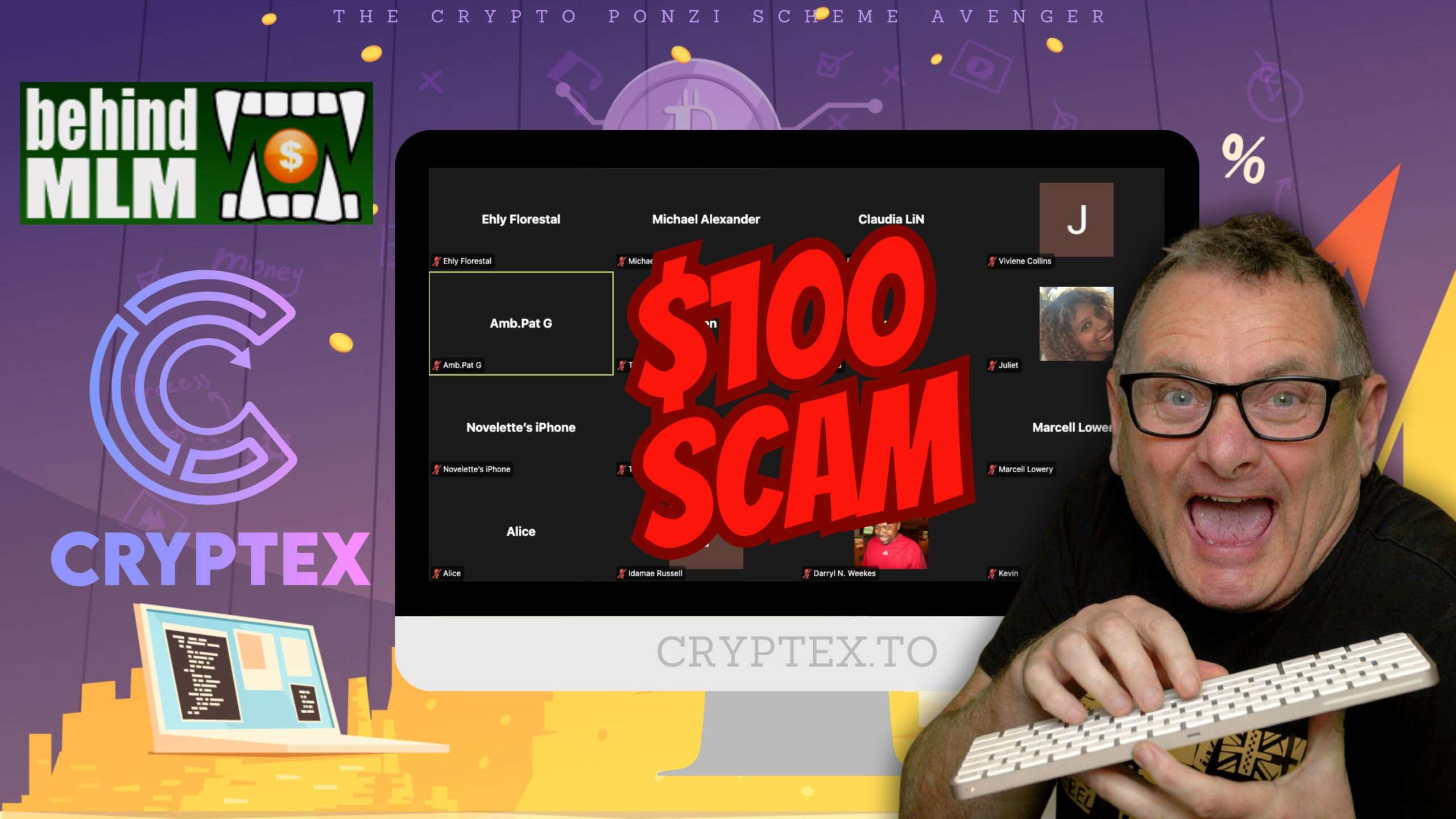My mission is simple: to expose and shame those running or promoting Ponzi schemes and scams while creating public awareness to protect “mum and dad” investors from losing their hard-earned money—and their children’s inheritance—to the multilevel marketing predators of the world.
Today, I’m taking a deep dive into Cryptex, a deceptive “investment” scheme that markets itself as a legitimate opportunity.
This article aims to inform and protect those who may believe Cryptex is a legitimate business. I’ll outline the red flags, break down the compensation model, and share a comprehensive review summary sourced from Behind MLM. If you’re considering investing in Cryptex, or know someone who is, this is a must-read.
What Is Cryptex?
Cryptex presents itself as a cutting-edge decentralized finance (DeFi) platform offering “risk-free investments” through smart-contract-based staking. It lures people in with promises of high daily returns, 24/7 profits, and an easy-to-use referral program.
But let’s be clear: Cryptex is a Ponzi scheme. Behind the flashy buzzwords like “DeFi,” “staking,” and “smart contracts” lies an operation that relies solely on recruitment and new investor funds to sustain payouts.
Red Flags That Expose Cryptex as a Scam
1. Unrealistic Promises of Risk-Free Returns
Cryptex claims to offer a “First Risk-Free Investment” and “no risk, no hassle, no worry.” Legitimate investments always carry some level of risk—there’s no such thing as a guaranteed return, especially in the volatile world of cryptocurrency.
2. Lack of Transparency
Cryptex does not disclose its ownership or executive team, a classic hallmark of scams. The domain “cryptex.to” was registered in August 2020 but remained dormant until mid-2021. Over 80% of traffic originates from Germany, but no regulatory compliance is mentioned.
3. Overemphasis on Recruitment
The Cryptex business model revolves around its referral program, rewarding participants for recruiting new investors rather than generating legitimate revenue. Payouts for referrals go up to 20 levels deep—this multi-tiered structure is a hallmark of pyramid schemes.
4. No Retail Products or Services
Cryptex has no products or services. The only way affiliates can earn money is by investing and recruiting others. This is a textbook indicator of a Ponzi scheme.
5. Lock-In Periods for “Staking Contracts”
Cryptex requires participants to lock in their funds for 3, 5, or 7 years, with no guarantees of returns. Long lock-in periods are commonly used by Ponzi schemes to prevent withdrawals while recruiting more investors.
6. Claims of “Sold-Out” Plans
The platform advertises “sold-out” 3-year plans, which likely means these positions are held by the admin or early adopters to create artificial scarcity and entice new investors.
7. Regulatory Red Flags
Cryptex operates as a passive investment scheme, constituting a securities offering. However, it is not registered with BaFin, Germany’s financial regulator, or any other global financial body. Operating without registration makes it illegal and fraudulent.
8. Poor Website Quality
The site is riddled with grammatical errors, buzzwords, and inconsistencies, such as mixing “Cryuptex” and “Cryptex.” This lack of professionalism is typical of scams thrown together quickly to extract funds before disappearing.
9. Fake Profit Projections
The platform shows “returns” in users’ dashboards that are likely fake. These returns are funded by the money of new recruits, not legitimate investments.
Cryptex Review Summary (Source: Behind MLM)
What Is Cryptex?
Cryptex claims to offer daily ROI through staking contracts. However, its compensation model and business practices expose it as a Ponzi scheme.
Compensation Plan Overview:
- Investments: Affiliates invest in $100 increments for promised daily returns over 3, 5, or 7 years. The $100 is retained as a “handling fee.”
- Referral Commissions: Up to 50% on level 1 and smaller percentages up to 10 levels.
- Residual Commissions: Up to 20 levels, starting at 8% on level 1.
Indicators of a Ponzi Scheme:
- Cryptex pays withdrawals from new investor funds.
- “Sold-out” plans likely mean early adopters are profiting to attract more investors.
- The scheme will collapse when new investments can no longer sustain payouts.
Regulatory Concerns:
Cryptex’s failure to register with financial authorities like BaFin makes it illegal. When the inevitable collapse occurs, the majority of investors will lose money.
Conclusion from Behind MLM:
Cryptex is a classic MLM Ponzi scheme disguised as a smart-contract innovation. Its unsustainable model operates illegally, putting investors at significant financial risk.
Why Cryptex Will Fail
Like all Ponzi schemes, Cryptex will collapse when it runs out of new recruits to pay earlier investors. The “staking” contracts are merely a smokescreen to delay withdrawals, giving the illusion of profitability while the admin siphons funds. Those who join late in the cycle—or fail to recruit aggressively—will bear the financial losses.
My Mission
As The Crypto Ponzi Scheme Avenger, I dedicate my time to protecting people from falling victim to schemes like Cryptex. My goal is to save everyday investors from losing their hard-earned money to these fraudulent operations.
If you’re considering Cryptex or know someone who is, take a step back and evaluate the red flags. Remember, if it sounds too good to be true, it probably is.
Final Thought
Cryptex promises wealth and freedom, but it delivers risk and ruin. Don’t let the flashy marketing and empty guarantees fool you. Stay informed, stay cautious, and protect yourself and your loved ones from scams like Cryptex.
Let’s work together to expose these schemes and ensure they don’t prey on the unsuspecting.







* The insurance ($300 per month), the bank fees (approx. 5.5% p.a.) and the administration fees ($30 per month) are paid from the “secure” staking rewards. But you have to pay the 100$ fee for the MLM yourself? Why? Why isn’t this also taken from the rewards, so that the scam suspicion would be invalid.
* If the business is so low-risk, why doesn’t the bank do it, or the insurance company? Or the developer community? Nobody needs the users. Nobody gives you money.
* Why is there an MLM system if the whole system is otherwise operated without any contribution from the users? A free system does not need advertising/advertisers. And: the developer community could have saved itself a lot of work if it had left out the unnecessary MLM system.
* Why is there always talk of Cryptex launching in 2017? According to the website, it was only available worldwide in 2020. But according to Webarchive, the page has only been available since the end of 2021.
The fact is what it says in Webarchive. Only this is a verifiable source. There is also no reference to Cryptex anywhere in the world before 2022.
There can therefore have been no payout of a 3-year contract. The ‘proof video’ and other claims about contract payouts are therefore false, lies and fakes.
* According to the website, life insurance is taken out to secure the loan???A life insurance policy!This is claimed several times (!) on the website (life insurance).
A freshly taken out, i.e. empty (!) insurance policy, taken out on an anonymous user (!), is supposed to be worth over $108,000? And be used to secure a loan of $30,000 or $40,000?
What kind of life insurance is this if no policyholder is specified?It cannot be an insurance policy that covers death.It is therefore a pure savings contract. Which insurance company takes out such a policy?
Which bank takes an empty savings contract as collateral for a loan that is also taken out for an unknown person?
* Staking is to be carried out on the ETH blockchain (Eterium) for the 3-year contracts. Yes, staking is possible on the ETH blockchain.Both Etherium and other coins on the ETH blockchain, so-called tokens.
However, I could not find any coins/tokens that yield such a high return through staking. Which coin would that be?
* For the 5- and 7-year contracts, staking is to be carried out on the BTC blockchain (Bitcoin).No, that’s not possible! The BTC blockchain contains Bitcoin as the only coin.So no other tokens.
* Staking is to be carried out on the BTC blockchain (Bitcoin) for the 5- and 7-year contracts.
No, that is not possible!The BTC blockchain contains Bitcoin as the only coin. So no other tokens.
And Bitcoin is not staked (=proof of stake = PoS), but mined (=proof of work = PoW). Mining is something completely different.No coins have to be bought beforehand for mining.The loan would therefore be nonsensical.
The BTC blockchain is neither token-, staking- nor smart contract-capable!
* Staking in the two different blockchains is intended to explain the different returns for the contract variants. But then why wasn’t the best blockchain chosen for all contracts if the developer community only wants the best for users?
* Why does the back office of Cryptex display the achieved capital in dollars?
For staking, coins must have been purchased using the credit!
Why can’t I see the coins, their number and their value?
The entire capital raised from the loan should be invested in cryptocurrencies. However, the coin itself is not only anonymous, but also non-transparent.
There is no insight into the blockchain.Why is that?That would have been easy to implement.
CRYPTEX is SCAM!!!
* In the back office, the value of the investment increases between 0.1 and 0.3% every day. So the investment is getting higher and higher.But that cannot be!
In the crypto market, values often fluctuate by 5% (or more) per day. You don’t see that with Cryptex.
The value of the coin or the total amount is therefore always treated with the purchase value of the coin. But this is wrong.
Staking increases the amount of coins in the world compared to the interest rate in a savings account. With such high rewards, this is a significant factor and almost automatically leads to a loss in value for the base coin! A coin with such high rewards therefore inevitably has a strong inflationary tendency!!!
* According to SuperLeader Mario Emmrich, there are already 500,000 contracts.
According to the website, there are 250,000 contracts (as of January 2022).
That would be 50 million dollars in fees for the pyramid/MLM and around 15 to 20 billion dollars in borrowing.
If there were to be payouts, that would be an estimated $200 billion.
Anyone who knows anything about the crypto market is probably laughing their head off here. The coin should already have a market capitalization of Cardano/ADA, at the time of the payout it would come close to ETH.
This is such bullshit.
* If the business really exists, what’s to stop the developer community from keeping the 100 billion themselves? Not your key, not your coin!!!
* When paying out rewards, it has been observed that payments go through the mixer.
Why is there an attempt to conceal the payment method?
This is mainly done for illegal transactions. The blockchain is anonymous even without the mixer.
Cryptex 2.0 has been announced for a whole year now. But it will not come, at least there will be no transparent insight into the blockchain.
Why not? Because there is no staking on the BTC blockchain!!!
Cryptex will be around until the middle/end of next year (2025) at the most. Then the first payouts will be due and these will not take place.
The whole thing is of course a scam, made by scammers with little knowledge of cryptos/financial business for the target group of “unsuspecting victims” and unsuspecting and/or greedy MLM networkers.
Absolutely awesome Intel thank you so much for spending the time putting it together
Hello Danny, I’m from Tanzania and I was influenced to buy a contract with cryptex. But after a long follow up of you in youtube I realized that this is a great scam!!! So please can you advice me of a better website that I can stake my money for profit? The one which is not a scam
I want you to wake up, there are no investment scams on the Internet they are all scams, I’m not a financial advisor you need to listen to me you were just going to keep losing your money. STOP giving away your money to the scammers
He the YouTuber ask him if he had any contract with cryptex. Sometimes you must not be fooled by these YouTubers.
Do due diligence yourself and if truly you’ve got a contract why not allow it to complete, then withdraw if after the timeframe to receiving your payment doesn’t then you can come and this YouTuber in his ignorance or the platform.
Where exactly do you think the money’s coming from? Magic? Cryptex isn’t generating real profit—it’s a lucky dip funded by new recruits. Classic Ponzi model. And as for asking if I’ve got a contract—mate, do you ask for a ‘contract’ when someone mugs you too? Contracts mean nothing if the whole system is built on lies. Waiting for a scam to collapse before calling it out is how people lose everything. Don’t get fooled just because someone on YouTube tells you what you want to hear—use your brain, not blind hope.
I agree it is a scam
But it’s not a crypto scam
You assume it’s crypto bc it’s called cryptex and it uses crypto as means of payment
But it’s staking it’s not a crypto staking
They use the term bc it works nowhere in their narrative does it come out to be a crypto staking platform
It’s vague so it can adjust
That what makes it a scam
My mission is simple: to expose and shame those running or promoting Ponzi schemes and scams while creating public awareness to protect “mum and dad” investors from losing their hard-earned money—and their children’s inheritance—to the multilevel marketing predators of the world.
Today, I’m taking a deep dive into Cryptex, a deceptive “investment” scheme that markets itself as a legitimate opportunity.
This article aims to inform and protect those who may believe Cryptex is a legitimate business. I’ll outline the red flags, break down the compensation model, and share a comprehensive review summary sourced from Behind MLM. If you’re considering investing in Cryptex, or know someone who is, this is a must-read.
What Is Cryptex?
Cryptex presents itself as a cutting-edge decentralized finance (DeFi) platform offering “risk-free investments” through smart-contract-based staking. It lures people in with promises of high daily returns, 24/7 profits, and an easy-to-use referral program.
But let’s be clear: Cryptex is a Ponzi scheme. Behind the flashy buzzwords like “DeFi,” “staking,” and “smart contracts” lies an operation that relies solely on recruitment and new investor funds to sustain payouts.
Red Flags That Expose Cryptex as a Scam
1. Unrealistic Promises of Risk-Free Returns
Cryptex claims to offer a “First Risk-Free Investment” and “no risk, no hassle, no worry.” Legitimate investments always carry some level of risk—there’s no such thing as a guaranteed return, especially in the volatile world of cryptocurrency.
2. Lack of Transparency
Cryptex does not disclose its ownership or executive team, a classic hallmark of scams. The domain “cryptex.to” was registered in August 2020 but remained dormant until mid-2021. Over 80% of traffic originates from Germany, but no regulatory compliance is mentioned.
3. Overemphasis on Recruitment
The Cryptex business model revolves around its referral program, rewarding participants for recruiting new investors rather than generating legitimate revenue. Payouts for referrals go up to 20 levels deep—this multi-tiered structure is a hallmark of pyramid schemes.
4. No Retail Products or Services
Cryptex has no products or services. The only way affiliates can earn money is by investing and recruiting others. This is a textbook indicator of a Ponzi scheme.
5. Lock-In Periods for “Staking Contracts”
Cryptex requires participants to lock in their funds for 3, 5, or 7 years, with no guarantees of returns. Long lock-in periods are commonly used by Ponzi schemes to prevent withdrawals while recruiting more investors.
6. Claims of “Sold-Out” Plans
The platform advertises “sold-out” 3-year plans, which likely means these positions are held by the admin or early adopters to create artificial scarcity and entice new investors.
7. Regulatory Red Flags
Cryptex operates as a passive investment scheme, constituting a securities offering. However, it is not registered with BaFin, Germany’s financial regulator, or any other global financial body. Operating without registration makes it illegal and fraudulent.
8. Poor Website Quality
The site is riddled with grammatical errors, buzzwords, and inconsistencies, such as mixing “Cryuptex” and “Cryptex.” This lack of professionalism is typical of scams thrown together quickly to extract funds before disappearing.
9. Fake Profit Projections
The platform shows “returns” in users’ dashboards that are likely fake. These returns are funded by the money of new recruits, not legitimate investments.
Cryptex Review Summary (Source: Behind MLM)
What Is Cryptex?
Cryptex claims to offer daily ROI through staking contracts. However, its compensation model and business practices expose it as a Ponzi scheme.
Compensation Plan Overview:
Investments: Affiliates invest in $100 increments for promised daily returns over 3, 5, or 7 years. The $100 is retained as a “handling fee.”
Referral Commissions: Up to 50% on level 1 and smaller percentages up to 10 levels.
Residual Commissions: Up to 20 levels, starting at 8% on level 1.
Indicators of a Ponzi Scheme:
Cryptex pays withdrawals from new investor funds.
“Sold-out” plans likely mean early adopters are profiting to attract more investors.
The scheme will collapse when new investments can no longer sustain payouts.
Regulatory Concerns:
Cryptex’s failure to register with financial authorities like BaFin makes it illegal. When the inevitable collapse occurs, the majority of investors will lose money.
Conclusion from Behind MLM:
Cryptex is a classic MLM Ponzi scheme disguised as a smart-contract innovation. Its unsustainable model operates illegally, putting investors at significant financial risk.
Why Cryptex Will Fail
Like all Ponzi schemes, Cryptex will collapse when it runs out of new recruits to pay earlier investors. The “staking” contracts are merely a smokescreen to delay withdrawals, giving the illusion of profitability while the admin siphons funds. Those who join late in the cycle—or fail to recruit aggressively—will bear the financial losses.
My Mission
As The Crypto Ponzi Scheme Avenger, I dedicate my time to protecting people from falling victim to schemes like Cryptex. My goal is to save everyday investors from losing their hard-earned money to these fraudulent operations.
If you’re considering Cryptex or know someone who is, take a step back and evaluate the red flags. Remember, if it sounds too good to be true, it probably is.
Final Thought
Cryptex promises wealth and freedom, but it delivers risk and ruin. Don’t let the flashy marketing and empty guarantees fool you. Stay informed, stay cautious, and protect yourself and your loved ones from scams like Cryptex.
Let’s work together to expose these schemes and ensure they don’t prey on the unsuspecting.
Thank you so much for sharing your perspective! I really appreciate your thoughtful take on Cryptex and the insight you’ve brought to this discussion.
You’re absolutely right—just because Cryptex uses cryptocurrency as a payment method and employs terms like “staking” doesn’t necessarily mean it’s a genuine crypto platform. Their marketing heavily leans into buzzwords like “Cryptex DeFi Hybrid Contract” and references familiar financial concepts like Certificates of Deposit (CDs) and staking pools, which can make it seem like a legitimate innovation. However, as you pointed out, this approach is incredibly vague—almost by design.
Looking at the text from their website, they position themselves as combining CDs, staking pools, and life insurance into what they claim is a revolutionary financial product. On paper, it sounds impressive: higher interest rates, no fees, decentralized crypto assets, and so on. But they don’t provide any concrete details about how they’re achieving these returns or even what “staking” means in their context. It’s like they’ve borrowed the language of both traditional finance and cryptocurrency to craft a narrative that works for anyone who isn’t familiar with the fine details.
The fact that their platform is vague enough to “adjust,” as you mentioned, is a huge red flag. Legitimate companies don’t need to be vague—they’re transparent about their processes, revenue models, and risks. Cryptex, on the other hand, seems to rely on ambiguity to keep people guessing while attracting investors who might be drawn to the buzzwords and promises of high returns.
Thanks again for pointing this out—it’s exactly the kind of analysis people need to see before getting involved in platforms like this. Hopefully, together, we can help more people spot these tactics and make informed decisions.
Why is my comment deleted? You this one below??
* The insurance ($300 per month), the bank fees (approx. 5.5% p.a.) and the administration fees ($30 per month) are paid from the “secure” staking rewards. But you have to pay the 100$ fee for the MLM yourself? Why? Why isn’t this also taken from the rewards, so that the scam suspicion would be invalid.
* If the business is so low-risk, why doesn’t the bank do it, or the insurance company? Or the developer community? Nobody needs the users. Nobody gives you money.
* Why is there an MLM system if the whole system is otherwise operated without any contribution from the users? A free system does not need advertising/advertisers. And: the developer community could have saved itself a lot of work if it had left out the unnecessary MLM system.
* Why is there always talk of Cryptex launching in 2017? According to the website, it was only available worldwide in 2020. But according to Webarchive, the page has only been available since the end of 2021.
The fact is what it says in Webarchive. Only this is a verifiable source. There is also no reference to Cryptex anywhere in the world before 2022.
There can therefore have been no payout of a 3-year contract. The ‘proof video’ and other claims about contract payouts are therefore false, lies and fakes.
* According to the website, life insurance is taken out to secure the loan???A life insurance policy!This is claimed several times (!) on the website (life insurance).
A freshly taken out, i.e. empty (!) insurance policy, taken out on an anonymous user (!), is supposed to be worth over $108,000? And be used to secure a loan of $30,000 or $40,000?
What kind of life insurance is this if no policyholder is specified?It cannot be an insurance policy that covers death.It is therefore a pure savings contract. Which insurance company takes out such a policy?
Which bank takes an empty savings contract as collateral for a loan that is also taken out for an unknown person?
* Staking is to be carried out on the ETH blockchain (Eterium) for the 3-year contracts. Yes, staking is possible on the ETH blockchain.Both Etherium and other coins on the ETH blockchain, so-called tokens.
However, I could not find any coins/tokens that yield such a high return through staking. Which coin would that be?
* For the 5- and 7-year contracts, staking is to be carried out on the BTC blockchain (Bitcoin).No, that’s not possible! The BTC blockchain contains Bitcoin as the only coin.So no other tokens.
* Staking is to be carried out on the BTC blockchain (Bitcoin) for the 5- and 7-year contracts.
No, that is not possible!The BTC blockchain contains Bitcoin as the only coin. So no other tokens.
And Bitcoin is not staked (=proof of stake = PoS), but mined (=proof of work = PoW). Mining is something completely different.No coins have to be bought beforehand for mining.The loan would therefore be nonsensical.
The BTC blockchain is neither token-, staking- nor smart contract-capable!
* Staking in the two different blockchains is intended to explain the different returns for the contract variants. But then why wasn’t the best blockchain chosen for all contracts if the developer community only wants the best for users?
* Why does the back office of Cryptex display the achieved capital in dollars?
For staking, coins must have been purchased using the credit!
Why can’t I see the coins, their number and their value?
The entire capital raised from the loan should be invested in cryptocurrencies. However, the coin itself is not only anonymous, but also non-transparent.
There is no insight into the blockchain.Why is that?That would have been easy to implement.
CRYPTEX is SCAM!!!
* In the back office, the value of the investment increases between 0.1 and 0.3% every day. So the investment is getting higher and higher.But that cannot be!
In the crypto market, values often fluctuate by 5% (or more) per day. You don’t see that with Cryptex.
The value of the coin or the total amount is therefore always treated with the purchase value of the coin. But this is wrong.
Staking increases the amount of coins in the world compared to the interest rate in a savings account. With such high rewards, this is a significant factor and almost automatically leads to a loss in value for the base coin! A coin with such high rewards therefore inevitably has a strong inflationary tendency!!!
* According to SuperLeader Mario Emmrich, there are already 500,000 contracts.
According to the website, there are 250,000 contracts (as of January 2022).
That would be 50 million dollars in fees for the pyramid/MLM and around 15 to 20 billion dollars in borrowing.
If there were to be payouts, that would be an estimated $200 billion.
Anyone who knows anything about the crypto market is probably laughing their head off here. The coin should already have a market capitalization of Cardano/ADA, at the time of the payout it would come close to ETH.
This is such bullshit.
* If the business really exists, what’s to stop the developer community from keeping the 100 billion themselves? Not your key, not your coin!!!
* When paying out rewards, it has been observed that payments go through the mixer.
Why is there an attempt to conceal the payment method?
This is mainly done for illegal transactions. The blockchain is anonymous even without the mixer.
Cryptex 2.0 has been announced for a whole year now. But it will not come, at least there will be no transparent insight into the blockchain.
Why not? Because there is no staking on the BTC blockchain!!!
Cryptex will be around until the middle/end of next year (2025) at the most. Then the first payouts will be due and these will not take place.
The whole thing is of course a scam, made by scammers with little knowledge of cryptos/financial business for the target group of “unsuspecting victims” and unsuspecting and/or greedy MLM networkers.
Reply….
1. Insurance, Fees, and MLM Structure
Red Flag: Why isn’t the $100 MLM fee taken from rewards?
Response: If the system is as profitable as claimed, it should easily absorb such costs. Instead, this external fee suggests reliance on participants’ funds, which aligns with MLM schemes rather than legitimate investments.
Validity of the Defense: Invalid. A truly secure and profitable system wouldn’t need users to pay upfront fees for participation. This model incentivizes recruitment over investment returns, which is a hallmark of Ponzi schemes.
2. Low-Risk Claims and Lack of Institutional Involvement
Red Flag: If it’s low-risk, why don’t banks or insurance companies adopt it?
Response: Institutions avoid this because it lacks credibility or verifiable financial backing. Legitimate low-risk opportunities are quickly adopted by the financial sector. The absence of institutional involvement is a red flag.
Validity of the Defense: Invalid. The claim that users are essential but institutions are not exposes a contradiction. No valid low-risk investment requires MLM participants.
3. MLM System Necessity
Red Flag: Why does a “self-sustaining system” need MLM?
Response: MLM incentivizes recruitment rather than product performance, which is unnecessary for legitimate products. This suggests that revenue likely comes from new recruits, not from the product itself.
Validity of the Defense: Invalid. The existence of an MLM layer is incompatible with a system claiming organic profitability.
4. Launch Dates and Web Archive Evidence
Red Flag: Claims about 2017 contradict Web Archive data showing activity only since 2021.
Response: This is verifiable via Web Archive. The inconsistency undermines claims of long-term reliability and payout history.
Validity of the Defense: Invalid. Proven falsehoods in timelines significantly damage credibility.
5. Life Insurance as Collateral
Red Flag: Empty life insurance policies on anonymous users used as collateral.
Response: No legitimate insurance or bank would accept such collateral. This is an absurd claim, reflecting a lack of understanding about financial products.
Validity of the Defense: Invalid. Life insurance cannot function as collateral in the manner described, and this claim is nonsensical.
6. Staking on BTC Blockchain
Red Flag: BTC blockchain does not support staking.
Response: The BTC blockchain uses Proof of Work, not Proof of Stake. Claims about staking on BTC are factually incorrect and indicate a fundamental misunderstanding of blockchain technology.
Validity of the Defense: Invalid. This is outright false and undermines any technical claims Cryptex makes.
7. Consistent Returns and Lack of Transparency
Red Flag: Daily returns of 0.1-0.3% contradict crypto market volatility.
Response: Such returns defy market norms and ignore fluctuations. Lack of visibility into the underlying assets raises transparency concerns.
Validity of the Defense: Invalid. Consistent, guaranteed returns are a hallmark of scams and contradict how crypto markets operate.
8. Unrealistic Market Claims
Red Flag: The scale of contracts implies unrealistic market capitalization.
Response: $200 billion in payouts would position Cryptex among top cryptocurrencies, which is unsupported by market data or any observable activity.
Validity of the Defense: Invalid. These figures are not substantiated and are likely fabricated.
9. Mixer Usage for Payments
Red Flag: Use of mixers to obscure transactions.
Response: Mixers are typically associated with illegal activities, and their use undermines transparency. Legitimate systems don’t require payment obfuscation.
Validity of the Defense: Invalid. Mixer usage raises significant legal and ethical concerns.
10. Cryptex 2.0 Delays
Red Flag: Cryptex 2.0 has been “in development” for a year with no updates.
Response: This mirrors a common scam tactic of delaying promised features to keep users invested.
Validity of the Defense: Invalid. Continued delays without explanation erode trust.
Summary
The responses provided defending Cryptex are largely invalid. The red flags—ranging from MLM reliance, false claims about staking, unrealistic market figures, and transparency issues—are consistent with scam characteristics. Cryptex appears to be a high-risk, potentially fraudulent scheme.
Danny do sollong.xyz please